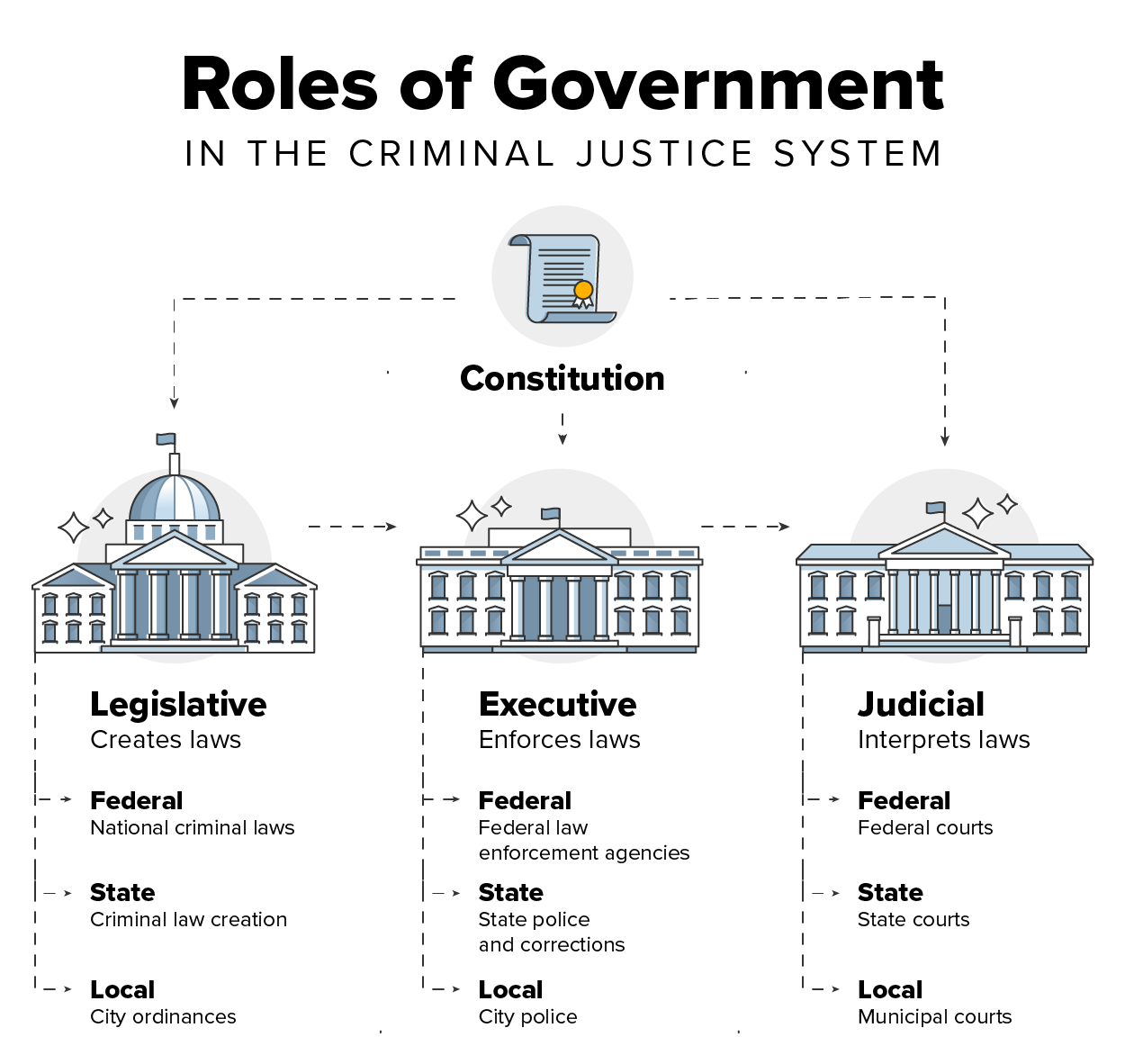Table of Contents |
The criminal justice system is an integral part of the government, with each of the three branches of government (i.e., legislature, judiciary, executive) playing a role and relying on each other to function effectively (USA Gov, 2023).

These branches operate at federal, state, and local levels, each managing different aspects of the system. At the federal level, the government oversees national criminal justice operations, while local governments handle city operations. Moreover, state governments are responsible for creating criminal laws and managing correctional facilities at the state level.
The term legislature refers to bodies that create laws, such as the U.S. Congress or state legislative assemblies. Legislatures play a crucial role in the criminal justice system by defining criminal actions and determining appropriate punishments through the creation of statutes, or formal laws organized into codes (USA Gov, 2023).
When referring to the criminal code, there is a compilation of statutes that outline criminal offenses. In the U.S., most criminal laws are established by state legislatures within the framework of dual federalism (Smith, 2006), which divides powers and responsibilities between national and state governments. Additionally, legislatures are responsible for allocating funding to support criminal justice agencies and programs.
The judiciary plays a complex role in the criminal justice system, reflecting its intricate hierarchical structure, which includes both trial courts and appellate courts.
The U.S. Supreme Court is the highest appellate court and the final authority on federal law matters. Its decisions can overturn those of lower courts and have a significant impact on law enforcement practices, including how police handle evidence, conduct searches, and interact with suspects.
Lastly, the United States operates under a dual court system (Gaines & Miller, 2021), comprising federal and state court systems. The federal courts handle cases involving federal law or constitutional issues, while state courts deal with matters pertaining to state law. Future lessons will delve deeper into the distinctions between these two court systems.
The executive branch of government is tasked with enforcing laws and includes officials such as the President of the United States, state governors, and city mayors. These leaders have significant influence over the criminal justice system, often making key appointments that shape its direction.
EXAMPLE
Mayors appoint police chiefs, governors select heads of law enforcement, and the President appoints federal judges, including Supreme Court justices, who have a profound impact on federal criminal law. The President also appoints heads of federal agencies involved in criminal justice, such as the heads of the Department of Justice, Federal Bureau of Investigation, and the U.S. Secret Service.Beyond appointments, the executive branch is crucial in setting criminal justice priorities and influencing public opinion (Newport, 2022). Officials at all levels must collaborate to develop policies that balance the needs of the public, victims, and defendants while upholding law and order.
In the executive branch, discretion includes the power to implement changes through executive orders or to grant clemency or leniency (Legal Authority Governing Executive Clemency, 2015), thereby shaping criminal justice policies and practices.
The criminal justice system aims to achieve three main goals (Diiulio et al., 1993):
Effectiveness involves executing the system’s functions to ensure equity and constitutional protections for both defendants and convicted offenders while also safeguarding public safety. The system must balance the needs and interests of the public, victims, and defendants, delivering justice while also protecting society from crime.
Fairness ensures that justice is administered impartially and consistently. This includes treating comparable offenders similarly and considering relevant legal factors during sentencing. Fairness is a core principle protected in the U.S. Constitution, guaranteeing that everyone is entitled to just treatment and their rights are upheld throughout the criminal justice process.
Source: THIS TUTORIAL WAS AUTHORED BY SOPHIA LEARNING. PLEASE SEE OUR TERMS OF USE.
REFERENCES
Diiulio, J., Geoffrey, P., Alpert, M., Moore, G., Cole, J., Petersilia, C., Logan, J., & Wilson. (1993). Performance Measures for the Criminal Justice System Discussion Papers from the BJS-Princeton Project by. bjs.ojp.gov/content/pub/pdf/pmcjs.pdf
Gaines, L. K., & Miller, R. C. (2021). Criminal justice in action. Wadsworth.
Justice.gov. (2015). Legal Authority Governing Executive Clemency. www.justice.gov. www.justice.gov/pardon/legal-authority-governing-executive-clemency
Newport, F. (2022). U.S. Public Opinion and the Role of Government. Gallup.com. news.gallup.com/opinion/polling-matters/404750/public-opinion-role-government.aspx
Smith, T. E. (2006). Dual federalism. Dual Federalism - Federalism in America. encyclopedia.federalism.org/index.php/Dual_Federalism
USA Gov. (2023, December 6). Branches of the U.S. Government. Usa.gov; USAGov. www.usa.gov/branches-of-government